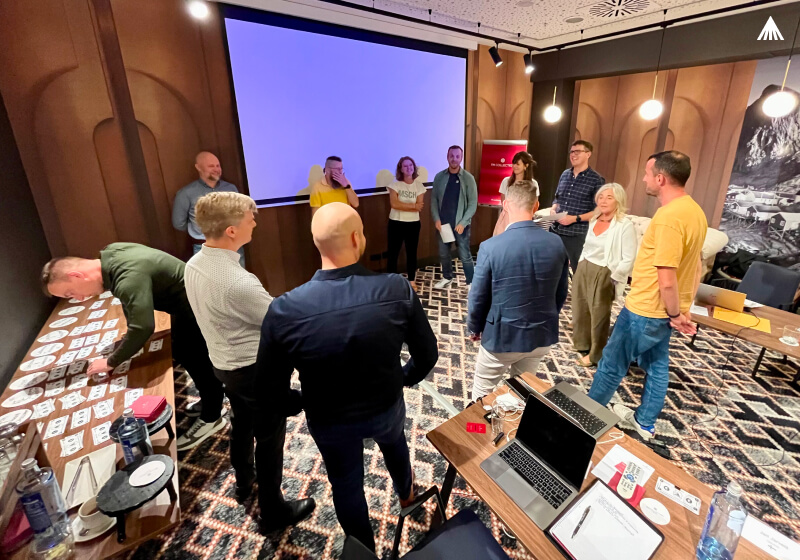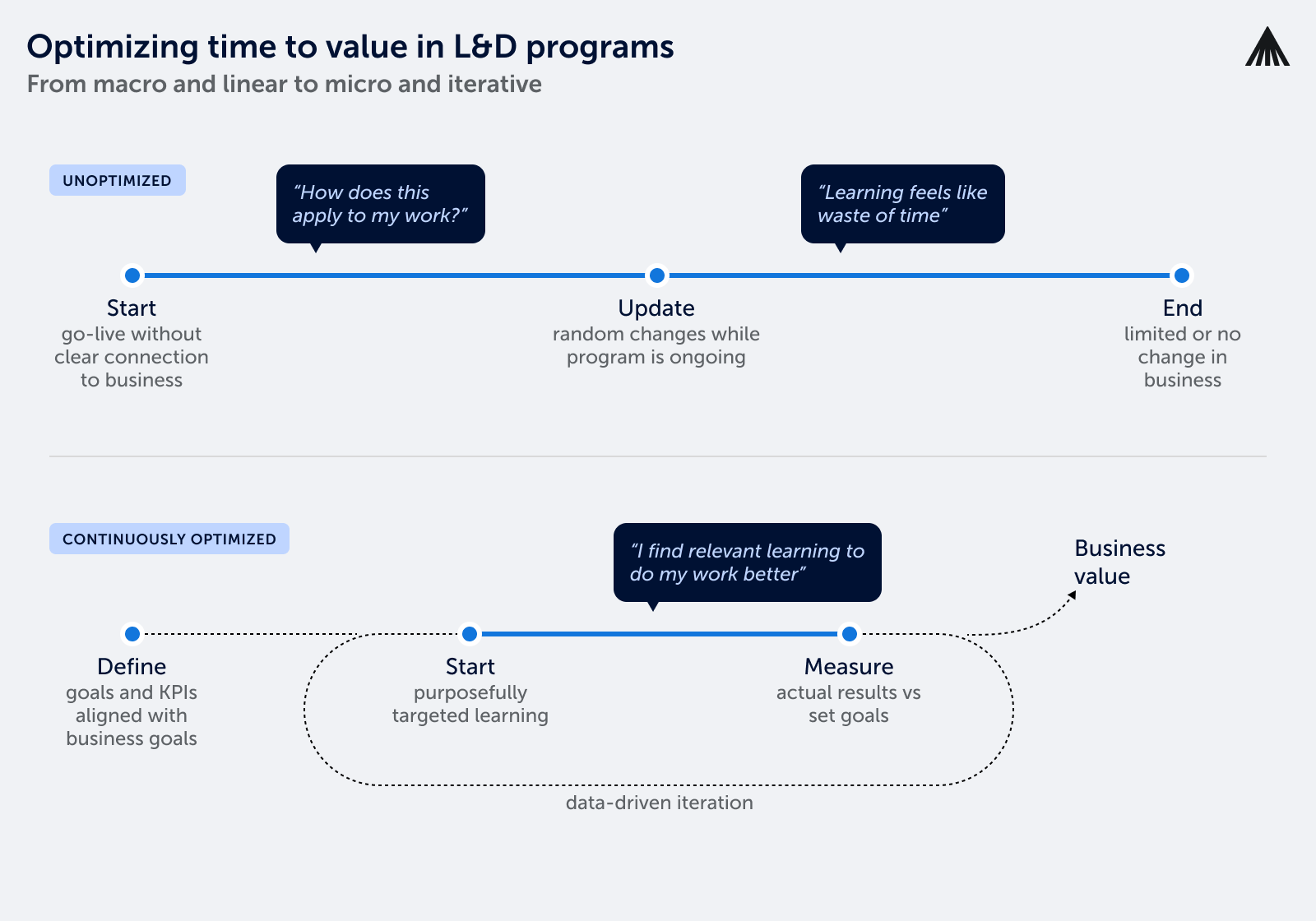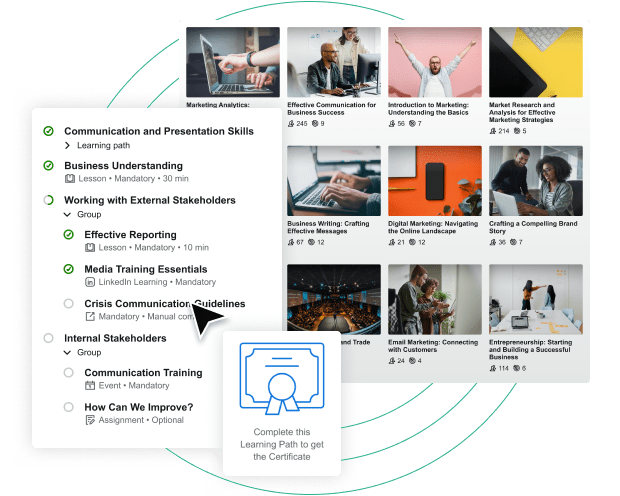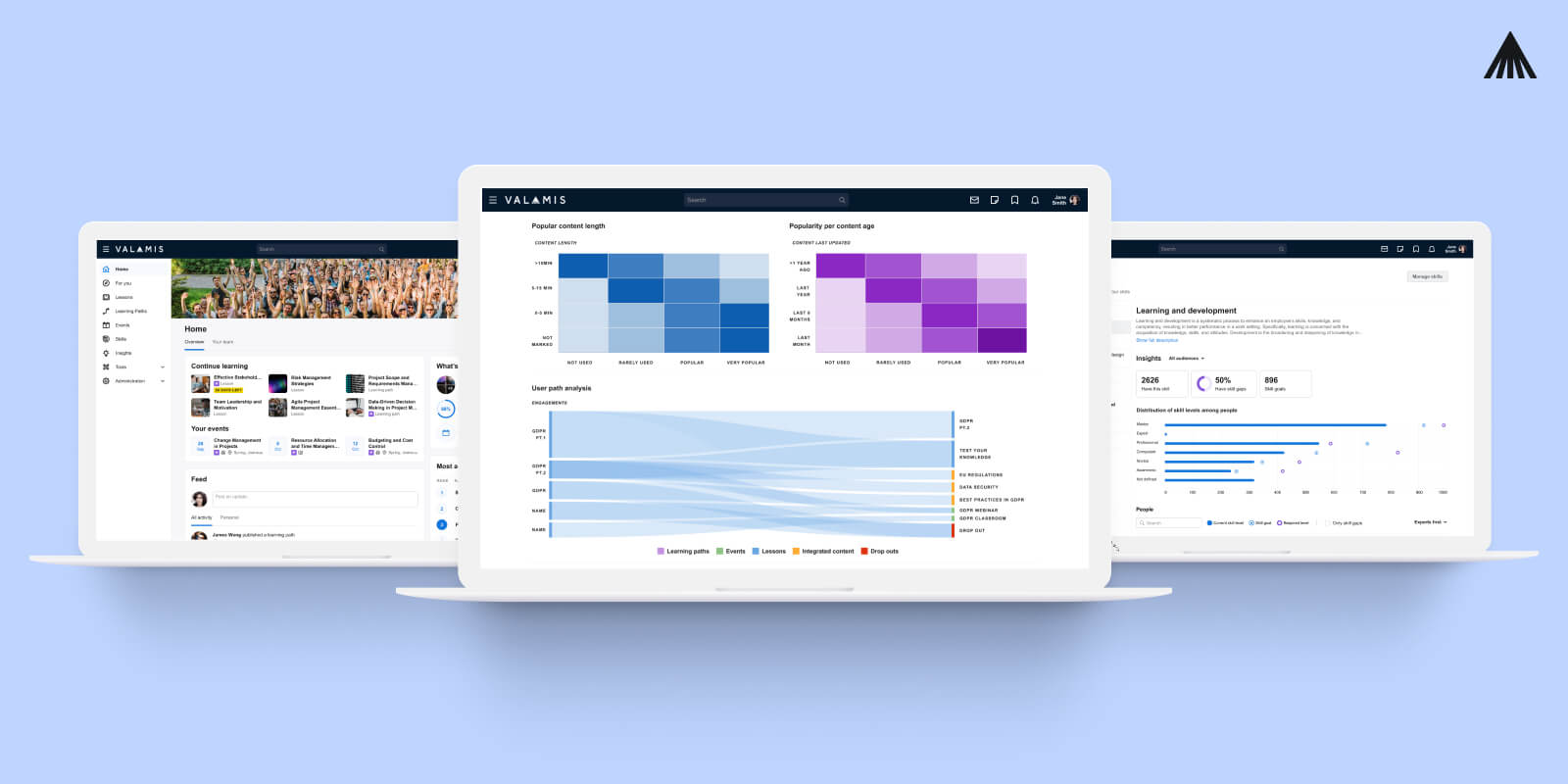How to minimize time to value in L&D initiatives
Why is time to value important? How do you track and calculate it, and how can you bridge the gap with modern technology.

Those who work in learning and development (L&D) are vitally aware that staying ahead of the curve is more than just a competitive advantage—it’s a necessity. But how do businesses separate the trends to take notice of over those that are merely fleeting?
As we delve deeper into this article, we’ll explore the significance of minimizing time to value in L&D, backed by data-driven decision-making and key performance metrics, offering organizations a roadmap to a more robust and responsive approach to professional development.
Discover:
- Understand the time to value metric in L&D
- Why is time to value important in L&D?
- How to track and calculate time to value in L&D
- Strategies to minimize time to value in L&D
- How to bridge the gap with modern technology
To answer this question and gain a deeper understanding of the current L&D landscape, we recently convened our Valamis Customer Advisory Board—a distinguished panel of industry experts, thought leaders, and our valued customers.

Valamis Customer Advisory Board session, 2023
During these sessions, we posed a series of questions, aiming to tap into the collective wisdom of these industry aficionados.
Two questions, in particular, stood out and generated compelling insights:
Question 1: In today’s dynamic landscape, what do you believe is the most pressing or significant trend in Learning & Development?
Answers: Minimize time to value. Provide training support in real-time and in a sustainable way. More data-driven decision-making in L&D
Question 2: Name 3 most important KPIs to measure for L&D initiatives.
Answers: Time to Value, Performance before and after, and People turnover rate.
After reviewing the feedback, we consistently encountered one key phrase: time to value, which wasn’t much of a surprise to us.
In today’s constantly changing environment, the focus on reducing the time required to see tangible results from L&D initiatives has become increasingly prominent.
Understanding the time to value metric in L&D
Before diving into the strategies, it’s crucial to comprehend the importance of the time to value metric.
At its core, time to value measures the duration it takes from the onset of a learning initiative until tangible benefits or outcomes are realized.
In simpler terms, it’s the gap between introducing a new training program and witnessing measurable results from that initiative, whether those are in the form of improved performance, enhanced skills, or any other predefined objective. Reducing this duration in a competitive economic landscape is pivotal for organizations to stay agile.

Why is time to value important in L&D?
- Immediate impact
In fast-growing industries, organizations can’t afford prolonged periods of training without seeing results. A reduced time to value ensures that employees can quickly assimilate and apply new skills, driving immediate impact.
- Resource optimization
A shorter time to value means that training resources—whether human, technological, or financial—are used more efficiently. It’s a more economical approach to L&D, ensuring maximum value with every dollar spent.
- Enhanced engagement
Learners are more likely to engage with training programs when they can quickly see the benefits of their efforts. A reduced time to value can lead to increased motivation and commitment to continuous learning.
- Strategic alignment
Focusing on time to value ensures that L&D initiatives always align with business objectives. When training programs are designed to deliver quick results, they’re more likely to sync with the organization’s immediate goals.
Further readings:
- How to Reduce The Cost of Employee Training: A Success Story
- How to Use LMS Data: Use Cases for Enhancing L&D Insights
How to track and calculate time to value in L&D
1. Define clear goals and metrics
Identify the goals. They should align with business objectives and be measurable, such as increased knowledge in a specific area, improved skill levels, or certification completion rates.
For instance, MadeiraMadeira tracked a 63% training completion rate as a key metric.
2. Monitor learner progress
Use analytics to monitor how quickly and effectively learners are progressing through training programs. Track metrics like course completion rates, assessment scores, and time spent on learning materials.
Examples include tracking engagement rates or completion times, as demonstrated by the Nordic Government Agency‘s approach, which led to significant time and cost savings
3. Evaluate impact on performance and business
Assess training’s immediate impact on performance and productivity, as seen in Helmes‘ case where their L&D strategy led to improved employee satisfaction and engagement.
5. Track engagement improvement
Measure the change in employee engagement before and after the L&D initiative, as exemplified by XP Inc.‘s successful adoption of the Campus XP platform, which significantly improved learner engagement and satisfaction.
6. Calculate time to value
Determine the time frame from the start of the L&D initiative to the point where significant improvements in KPIs are observed. This period is your time to value.
Watch the video in which Samuel Van Kiel of Valtech shares his advice for those who are new to learning data.
Strategies to minimize time to value in L&D
Organizations can significantly reduce the time it takes to realize value from their L&D efforts by adopting certain methodologies and focusing on key areas. Here are some strategies that have proven effective in achieving this goal:
1. Align with business goals
Before designing any L&D program, ensure it aligns with the overarching business objectives.
This alignment guarantees that the skills being developed are directly contributing to organizational success, thus improving the return on investment (ROI).
Read: How to Connect Your Learning Data to Your Business Success
2. Utilize microlearning
Instead of lengthy training sessions, focus on bite-sized, focused content.
Microlearning is more digestible and caters to the short attention spans of today’s learners. It also allows employees to quickly apply what they’ve learned, which can bring immediate value.
3. Personalize training
Every learner is unique.
By leveraging data to understand individual learning styles, competencies, and gaps, L&D professionals can create personalized learning pathways. This ensures that learners get exactly what they need without wasting time on redundant or irrelevant content.

Valamis’s Learning Paths offers a streamlined journey for learners to set, follow, and accomplish their educational goals with ease and clarity in a contemporary, user-friendly environment
4. Apply agile methodologies
Borrowing from the world of software development, agile methodologies in L&D emphasize short, iterative cycles of content creation and feedback.
This approach allows for swift course corrections, ensuring that the L&D initiatives are always relevant and valuable.
5. Foster a culture of continuous learning
In fast-changing business environments, one-time training isn’t sufficient.
Encourage continuous learning by making resources readily available and promoting a culture where seeking knowledge is the norm.
6. Measure and iterate
Just like any other business function, L&D initiatives should be consistently measured for efficacy.
Collect feedback, assess knowledge retention, and look at how the skills are being applied in real-time. This will provide actionable insights for course corrections.

Learning analytics and reporting at Valamis
Read: How to Measure and Evaluate Training Effectiveness
How to bridge the gap with modern technology
While strategic alignment, tailored content, and continuous feedback are critical components of minimizing time to value, the role of technology cannot be understated.
The power of native data collection in modern LMS
A modern LMS isn’t just a platform for delivering content—it’s a rich source of data that can provide invaluable insights. Here’s how:
- Instant feedback
From the get-go, native data collection in a modern LMS provides insights into how learners interact with the content. This means L&D professionals can make instant tweaks to enhance engagement and understanding.
- Predictive analysis
By analysing patterns, LMS data can help predict which learners might struggle with certain content or identify modules that might have unclear instructions.
- Tailoring content
The data can showcase which parts of the content are most and least interacted with. This can guide L&D professionals in refining their content strategy, focusing more on what works and improving or eliminating what doesn’t.
- ROI visualization
By linking LMS data with business performance metrics, it’s easier to visualize and quantify the direct impact of L&D initiatives on organizational success.
- Improving time to value
With real-time data, it’s possible to see which learning interventions are producing immediate results. This can help in rapidly scaling successful interventions across the organization.
Read: What is the Difference Between LMS and LX
Conclusion
As our Customer Advisory Board highlighted, aligning L&D strategies with business goals, harnessing the power of modern LMS, and making data-driven decisions are no longer optional – it’s imperative. By embracing these insights and strategies, organizations can ensure that their L&D initiatives remain agile, impactful, and, most importantly, aligned with the broader vision of organizational success.
We at Valamis are proud to share a range of customer success stories, highlighting how various organizations across sectors like retail, public sector, renewable energy, professional services, financial services, nonprofit, and aerospace have benefited from our learning solutions.
Each story is a testament to specific achievements such as improved training completion rates, increased content creation, cost savings, enhanced learning engagement, and the development of holistic learning ecosystems.
These real-life examples underscore the effectiveness of our approach in tackling diverse L&D challenges. For more detailed insights into each case, we invite you to explore our Customer Success Stories.

Turn data insights into actions
Make every lesson count. Data insights from our LMS ensure your team’s development is always on track.
Learn more



